I am a month into the second semester of the Indonesian school year, and teaching is still the heaviest occupant of my thoughts every day. Did they enjoy today’s lesson? Are they learning something meaningful? Do they understand what I’m trying to do? Do they look forward to English class? DO THEY LIKE ME?
It is already February (5 months passed like a bullet), and I am now in the home stretch of the grant. Teaching the 10th grade students at SMAN1 has been the most creatively challenging, physically exhausting, fret-inducing, and just all-around fascinating learning experience I have ever taken on, and I wanted to use this post to share some of the adventures I have had with my students in the last five months.
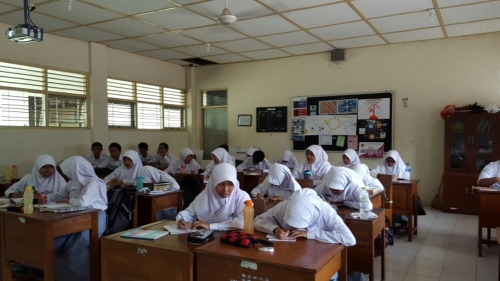 What my classroom typically looks like. 30 students to a class. 10 classes.
What my classroom typically looks like. 30 students to a class. 10 classes.
I’ll start with my very first lesson plan.
The national curriculum topic for that week was “Expressions of Congratulations.”
An oddly specific lesson topic, but sometimes specific makes it easier to lesson plan. Out of all the possible things they could be learning about the English language, I’m not sure focusing on how to congratulate someone was the most practically useful, but nevertheless this remains one of my favorite lessons of all time.
We began with a warm-up activity in which my co-teacher showed a photograph of a student receiving a trophy and the students could ask questions about the photograph to guess what was happening in the picture and what the lesson would be about.
Then we jumped straight into Jeopardy. There’s a theory that the way teachers teach is completely shaped by the way that we learned when we were students, and if there’s anything I remember about being a student it was playing Jeopardy in AP Biology class. I don’t think I realized back then how cool of a teacher Mr. Jones was for having slides that said “Baba Ganoush” after you answered questions correctly about the Krebs cycle. Jeopardy is quite possibly one of the most versatile teaching tools. In AP Bio we used it for review. In this lesson, I used it to introduce different expressions of congratulations. The students were divided into two teams and the teams chose from categories like “Family” or “School.” Then I read an example of a congratulatory expression out loud.
Example, “Family for 300” would be “Congratulations on your new baby boy!” and if students could guess the real life situation that corresponded to that expression, they would get 300 points. Later on in the game, I sometimes gave the situation and asked for an expression to see if they picked up on some of the new expressions.
Jeopardy worked wonders because it was a listening activity that came with the excitement of a game show, and it put competitive pressure on my otherwise very shy students so they were raising their hands like lightning before they could remember that they were shy. It was also a way for me to show them all the different ways to congratulate someone in different situations without having to do the traditional white-board/take notes method.
It was amazing how seriously the students took Jeopardy. My favorite part was watching the little heads bump together to whisper to each other for a split second before snapping back to declare an answer, or the thunderous cheering when I gave them their points in my best game show voice possible. As the native speaker, I did the reading out loud, and my co-teacher manned the points for each team on the white board, and together we kept a nice rhythm until our jeopardy board was all crossed out.
We’ve been taught in teacher trainings that generally, after presenting new material, a lesson should progress to having students practice and then ultimately produce the material on their own (formally called the PPP method of lesson planning for Present, Practice, and Produce).
For the practice portion of this lesson, my co-teacher and I had students pair up, and we gave each pair a picture ranging from sports tournaments to wedding anniversaries. One partner had to come up with an achievement based on the picture and the other partner would congratulate them accordingly. I’m a huge fan of using pictures in class because it gives students somewhere to start but it forces them to think of their own vocabulary.
The final part of the lesson consisted of one of my favorite activities of all time – it’s a game I made up to try and get the students conversing with each other without thinking too much about it. I put on some music and told the students to wander around the classroom. When the music stopped, students would have to grab the nearest person and strike up a conversation – telling their partner one of their own personal achievements, and their partner would congratulate them and continue the conversation. This game had the thrill of musical chairs and the candidness of spontaneous conversation. The excitement of scrambling for a partner was great for fueling enthusiastic conversation without them realizing it. It’ll be a long time before I forget the image of my students parading around the classroom like a train, hands on each others shoulders, a marching chorus of Maroon 5 that would scatter into a million squeals at the touch of the pause button.
The reason why I like this lesson is because it had variety and diversity of skills. Jeopardy was teamwork, pictures were pair work, and musical partners was individual thinking. Jeopardy was listening and contextualizing, pictures were practicing in the comfort zone of a picture and a partner, and musical conversations was synthesizing on your own in a random situation that you’re thrown in. I thought the lesson was a win, but what did they think?
For their exit ticket, I asked them to write one thing they liked about the lesson, one thing they learned, and one thing they would like to do next time.
Exit tickets are kind of a guilty pleasure for me because afterwards I feel like all of my students just wrote me private notes, but they’re also great because I am always wondering what they’re thinking. I think for the most part, this was the first time they ever played games like that in English class – the first time they ever had pop music in class, the first time they were asked to get out of their seats and wander around the classroom.
Few things feel better than a happy class. Going through a lesson plan from start to finish is like white water rafting. Push off strong, ride all the waves, work around the rocks, keep tabs on all paddlers, and then let the leftover adrenaline ooze as you finish smooth sailing.
It can feel as boss as dodging all the rocks in an even rhythm, and it can feel as helpless as getting stuck backwards on a boulder with paddles and limbs flying in the air.
Here are some other activities I’ve done in the classroom.
TEAM STORYBUILDING
One of my favorite writing activities. During a lesson about the simple past tense, my co-teacher and I divided the class into three teams. Each team was responsible for making a story that fit their genre. The first team was in charge of making a comedy, the second team made a romance, and the third team made a thriller. I gave them one sentence to start off with, and the rest was up to them to complete in a relay race format. Each team formed a line in front of their part of the whiteboard, the first person in line wrote one sentence, handed the marker to the next person in line, and went to the back of the line. The next person continued the story with another sentence, and so on.
What’s great about story building on the board is that afterwards, we could go over spelling or grammatical errors together as a class. One piece of advice I got during orientation was that it’s better to have students do an activity before you start teaching new material like grammar, because it isn’t until then that you can see where student needs really are. In these lessons, it wasn’t until the stories were on the board that I realized my classes needed a lesson on conjunctions, and we were able to take 10 minutes on the spot to learn how to make conjunctions and where conjunctions would have fit into their stories.
Some of these stories had me in stitches- like when James Bond “jumped out of the helicopter and Goldfinger shot him while he was still airborne but fortunately his car was waiting for him with Sam Smith inside it.”
DESCRIBING PEOPLE
For this activity, there were five students in the front of the room, who were potential suspects in our detective investigation. Another student would silently choose one of the five to be the “suspect.” The rest of the class could ask questions like “does your suspect have glasses?” or “is your suspect wearing a watch?” and based on the yes or no answers, the class would guess which individual the student had picked. This activity was actually intended to be done with a picture of five different characters on the projector, but in one of the classes the projector wasn’t working. My co-teacher asked if we should scrap the whole activity, but I glanced around the classroom, picked five students that looked different enough, and we improvised by using real people instead. A skill that is absolutely essential to teaching: being resilient, flexible, and able to improvise (creatively) on the spot. In Indonesia, classroom technology isn’t the most reliable, and it helps to be able to bounce back fast.
HOT SEAT
Hot seat is a great activity for describing people. A student sits in the hot seat at the front of the room with his/her back to the whiteboard. Another person writes the name of a person on the board and the rest of the class has to help the person in the hot seat guess who it is by using descriptions only.
On this particular day, it was Kamis Pahing, a special day that comes around every month or so where students and teachers wear traditional Javanese clothing. It marks the day on which the 7 day solar calendar lines up with the 6 day Javanese calendar for a day. Women wear kebayas and men wear surjans. It’s awesome. I love Kamis Pahing.
PRESENTATIONS
Good old fashioned presentations. A student’s worst fear and potentially the most uncomfortable 90 minutes of class if students aren’t feeling it and are reluctant, but with a couple tweaks and the right momentum presentations can be a great time. In this lesson we were learning how to describe places, and I asked students to present on a place they’ve always wanted to go to. Ways I tried to make presentations more fun and interactive:
- Present in pairs – students felt much more comfortable when they had a buddy.
- Make it competitive – put pairs up against each other to see which team could better persuade the class to want to go to their destination
- Give the audience a task so they don’t goof off – the rest of the class had to vote on which place they would rather visit based on each pair’s presentation
- No notes – After one or two students gave their entire presentation with their nose in their paper, I seized the opportunity to switch up the rules while we were still early in the game. I told the class we were adding an extra challenge – you may not use your papers. After the gasps of horror passed, the students totally rose to the challenge (they didn’t have a choice) and gave stellar presentations. They were stellar because they were candid. They were forced to be candid. Hah.
One of the really endearing highlights of this lesson, though, was how many students wanted to go to Mecca and complete the Hajj. I really love when I get a glimpse of my students’ spirituality in class. A couple weeks before that I was reading essays of many students who admired their mothers for never missing a prayer. The majority of the students at SMAN1 are Muslim, and Islam is a large part of the school’s daily schedule. Students read the Qur’an over the loudspeaker on Monday mornings. They pray at noon. They gather in small group discussions all over the school grounds on Friday afternoons to discuss the Qur’an. They have large assemblies of religious lectures in the auditorium every so often. My students are great examples of religious discipline, and I admire them a lot for that.
SKITS
Skits were a great way to get a glimpse of students’ personalities. One of the topics last semester was “announcements” which I thought was an extremely boring topic (the national curriculum can be as strangely specific as announcements one week and as vague as recount text another week), but it was made infinitely better with acting. I typed up situations in which announcements are relevant, like “you just saw a flyer for a local concert and you want to tell your friends about it” or “you just saw an advertisement on the internet about a tourism package and you want to convince your parents to go,” and asked students to come up with skits that would act out the scenario and include all the components of an announcement. These turned out to be absolutely delightful, and most of the time downright hilarious. One student, Fienna, gave a superb Romeo & Juliet-like performance of dramatically choosing to end her life with a knife to the heart when her parents refused to take her up on the vacation package.
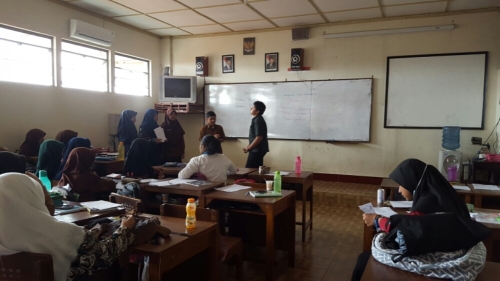 Aditra, speaking in the picture above, even broke down which airline you would take based on what economic class you belonged to. lol!
Aditra, speaking in the picture above, even broke down which airline you would take based on what economic class you belonged to. lol!
PICTIONARY
Towards the end of last semester, the students were stressed out about exams, so my co-teacher and I decided to have a class dedicated to some fun English vocab games to give students one less class to stress out about. We played pictionary on the whiteboard and charades, which had me laughing the hardest I’ve ever laughed in front of my students – that kind of silent laughter that comes when you’re laughing so hard you can’t do anything for a couple of seconds.
A lot of my students ask me what the difference is between Indonesian and American schools.
Objectively, Indonesian schools pack in many more subjects. During midterms and finals, my students are studying for 15 subjects at once (extra subjects that we don’t have in America would be things like religion, Javanese, etc.). This enormous breadth of subjects is achieved at the cost of depth of material. For example, Indonesian students only have English for 90 minutes once a week. Learning a language requires constant reinforcement and practice, and you can see why this makes it difficult for both students trying to master English and teachers trying to ensure steady improvement. A lot of the victories we have in the classroom feel like they’re dissipated in the 6 days before I see those students again.
Subjectively, I’ve noticed that in Indonesian classrooms, there is a really strong collectivist culture where students will always check with their partners, if not everyone around them, before speaking. Students are always at the ready to help other students out with the correct answer, even when it means hollering out the right pronunciation in the middle of a student’s presentation, and this takes precedence over the independent thinking and individual participation that’s encouraged in America. More often than not, I receive answers in the form of a chorus rather than a raised hand. Overall, the energy, enthusiasm, and respect for teachers in Indonesian classrooms is higher than that in America, and this has made teaching here a real pleasure and a privilege.
2nd SEMESTER
Before the second semester began, all 34 ETAs flew to Jakarta for a midyear conference during which we received some really practically relevant training from English Language Fellows in Indonesia (very qualified English teachers from America teaching ESL abroad). The conference came at a great time – we all had a semester of teaching successes and challenges under our belts and we were all looking for some new inspiration for the new semester. My own personal takeaway from the abundance of advice and direction we received at the midyear conference was when one of the language fellows ended her presentation with some real talk.
We could carry out our lessons about the English language talking about Sally and David in the park, or we could take the opportunity to incorporate global issues into our examples and reading passages and teach students meaningful things while they learn a new language.
This struck a chord with me, and with Martin Luther King Day and Black History month quickly approaching, I sat down with my co-teacher and crafted a lesson about Martin Luther King Jr., Rosa Parks and the Montgomery Bus Boycott, and the March on Washington.
My co-teacher and I centered this lesson around reading comprehension. As much as I would love to get my students conversing in English all day, at the end of the day their exams are almost all reading comprehension, and I wanted to cover that in class as well. For this class, my co-teacher and I pieced together a biography/narrative of Martin Luther King Jr. and his larger civil rights movements and had students answer questions about the passage at reading stations. We divided the students into groups of 4 and set up biographies all around the room.
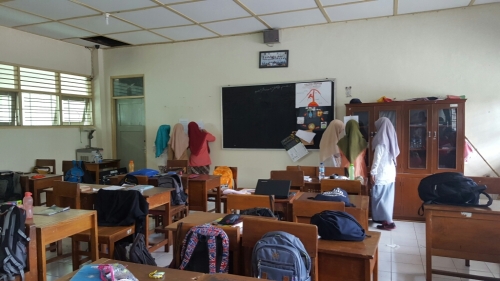 It was basically group reading comprehension on the wall, but it’s incredible how just the slightest switch-up can make a boring activity much more fun. The simple action of taping the biographies on the walls made students view this activity as something new- something different from an ordinary bland reading exercise- and having the paper on the wall turned out to be much easier for the students to read together at the same time, which I realized they wouldn’t be able to do if they were sitting down and reading at their desks and spinning the paper around until everyone could get a turn to look at it.
It was basically group reading comprehension on the wall, but it’s incredible how just the slightest switch-up can make a boring activity much more fun. The simple action of taping the biographies on the walls made students view this activity as something new- something different from an ordinary bland reading exercise- and having the paper on the wall turned out to be much easier for the students to read together at the same time, which I realized they wouldn’t be able to do if they were sitting down and reading at their desks and spinning the paper around until everyone could get a turn to look at it.
I really wasn’t sure how a lesson on racism and the civil rights movement was going to be perceived by Indonesian students. In Indonesia, the general sentiment around skin color has a lot to do with perceptions of beauty – a lot of Indonesians think fair skin is more attractive than darker skin. People are constantly covering up in the blazing sun (down to the fingertips with pink fuzzy gloves) to avoid getting tan, and hygiene and beauty products all contain whitening agents. Regardless, my students seemed to grasp the seriousness of racism and the importance of civil rights, although I was wondering why some students were consistently getting one of the reading comprehension questions wrong. Then it occurred to me that I had assumed they would be able to perceive why Rosa Parks refusing to give up her seat on the bus would be a big deal. I realized I had to explain (with a diagram and some acting) what segregation on buses and in schools looked like in the first place before proceeding to talk about the civil rights movements that ensued. Explaining what segregation was like in America out loud to my students made it feel even more absurd, and the genuine concern and furrowed eyebrows on my students upon hearing stories of segregation confirmed that.
WORDS
Every year, the Indonesia ETAs hold local English Speech Competitions at their schools, called the WORDS competition. It’s a creative English speech competition that gives students the freedom to incorporate any talents (music, dance, poetry, acting, comedy, etc.) into their speech. The winner from each local school travels to Jakarta, courtesy of the American Indonesian Exchange Foundation (AMINEF), to deliver their speech alongside winners from every other ETA’s school in the national WORDS competition.
This year’s topic is
If you had three wishes to change something about the world, Indonesia, or yourself, what would you wish for?
Brainstorming for this topic has yielded incredible results. It was like an in-class rally as students shouted out words like “Corruption!” or “Education!”
Some ideas were derived from recent news, like ISIS and terrorism. Some ideas were fueled by personal experiences, like the Indonesian curriculum or bullying or public transportation and pollution in Indonesia. Others sprang from personal interests, like space research, and others came from places of impressively deep thought and global awareness, like the public perception of Muslims, or perceptions of beauty.
I’m still in the middle of working with students to develop their ideas into speeches. My main focus is for them to incorporate as many specific personal stories as possible to explain the basis for their three wishes – like their personal experiences with pollution, bullying, the curriculum, tolerance, etc.
Whereas last semester was chock full of interactive and fun activities to get the students up and running around using and liking English, my focus this semester has shifted to longer, somewhat more serious projects. There’s less laughter and joking around in the classroom, which I miss, but it’s being replaced with deeper thought and discussion, which I really hope the students are liking as much as I am.
Having an influence over 300 high school students’ perception of English is frightening, thrilling, challenging, and so so rewarding.
Teaching has not come without challenges. Sometimes a class is just hot and tired and not feeling the lesson, and I am pulling teeth to get students to participate. Sometimes group work turns into “only the people Miss Julia is sitting with need to work.” Sometimes trying to help an individual student turns into a scared and confused student shaking their head at me thinking what does she want from me?!? Sometimes students get sarcastic. Sometimes students just refuse to present. But when I sat down to write this post those simply weren’t the first thoughts that popped into my head. The first images that came to mind were the smiling faces and chorus of “good morning”, or the boisterous witty remarks from the boys in the back corner. Or the laughter of students in the middle of a game, or the sea of heads bowed down in brainstorming. The ever so satisfying nod of students who understand, or the split second shock when a student says something so incredibly insightful.
These are all just a taste of what it’s like to teach in Indonesia. The student that is face-down passed out in the corner of class is outweighed, outnumbered, and outshined by the students who come to the teacher room during breaks or after school to bounce around ideas for their speech. Just when I feel like I’ve failed when a student haphazardly throws down two sentences for a presentation and sits down, another student brings the house down with a performance worthy of a standing ovation. Just when I feel like a class could really care less about my existence, a student asks for my help with editing an essay after school.
I am not a certified teacher, and I have not had classroom teaching experience prior to coming to Indonesia. All I have is something close to resembling desperation for these students to have a good time in the classroom and for them to try new things. I would not be able to muster up the energy to try and move 300 students every week if it weren’t for the enthusiasm that my students reflect back. At the end of the day my teaching experiences in Indonesia have been positive by and large because of the open-mindedness of my co-teacher and the encouragement and support I get from the smiles and cheer of the students of SMAN1. Their willingness to hear me out, to holler out their thoughts, and to try new things with me is what gets me to splash cold water on my face every morning and speed off to school on my motorbike at 7am.



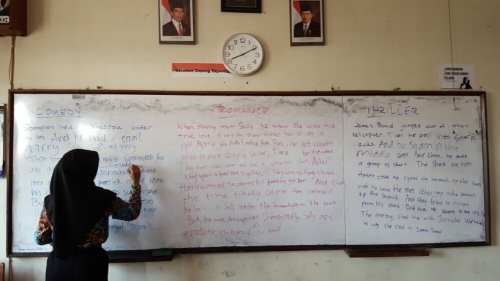

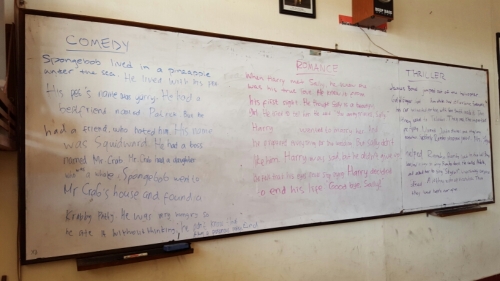
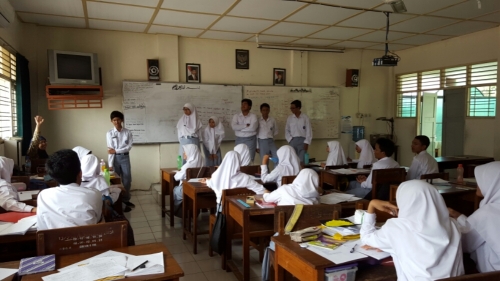
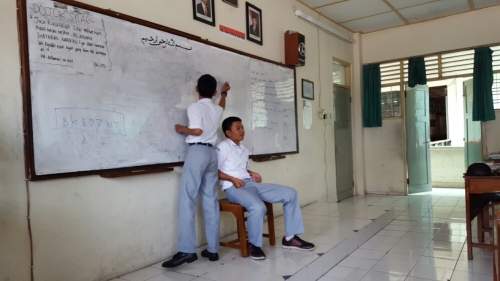
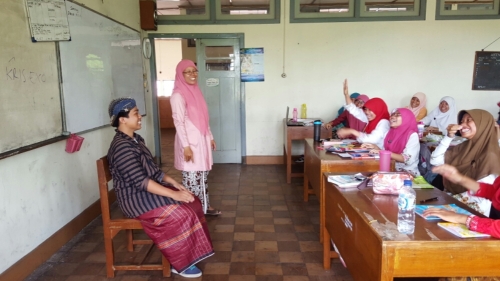
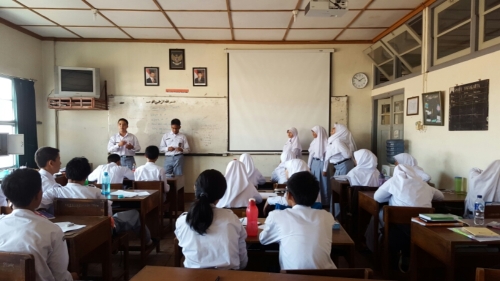
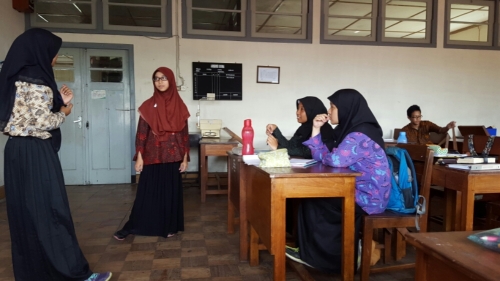
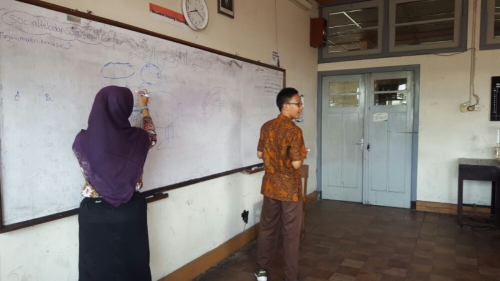
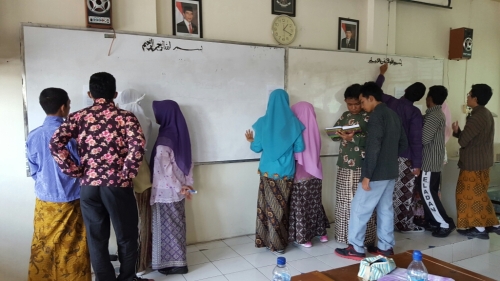

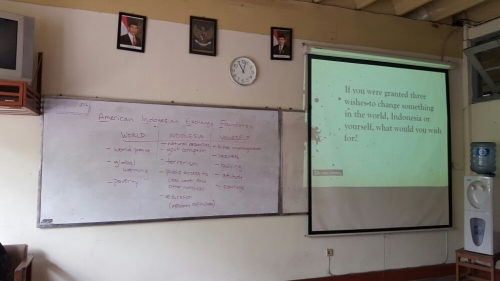
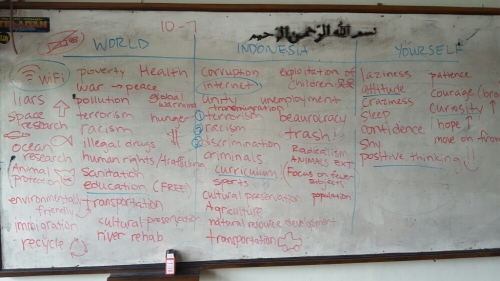
Loved reading this! This article is filled with so much insight into the world of teaching. I feel like I understand my current professors’ point of view more after reading this. Thanks for the share ^^
LikeLike
I loved reading this! This article shares so much insight into the world of teaching. I feel like I understand my professor’s thinking a whole lot more after reading this. Thanks for sharing ^^
LikeLike